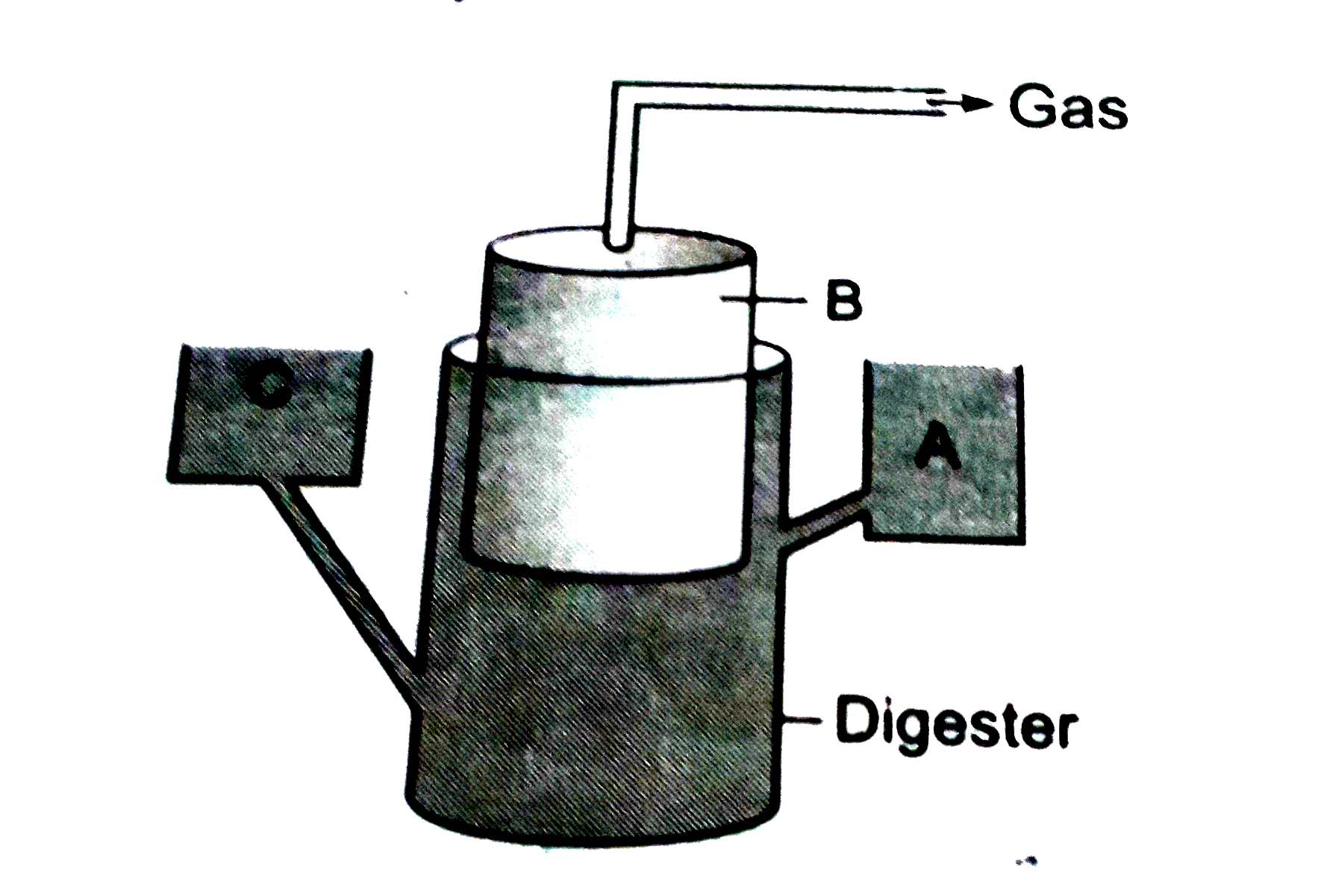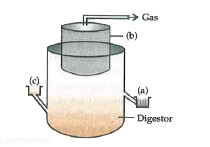The diagram above is that of a typical biogas plant. Explain sequence of events in a biogas plant. Identify a, b and c.
Step-by-Step Solution:
1. Understanding Biogas:
- Biogas is a renewable energy source primarily composed of methane (50-70%) and carbon dioxide (30-40%), with trace amounts of nitrogen, hydrogen sulfide, and hydrogen. It is produced through the anaerobic digestion of organic materials.
2. Identifying Components:
- In the diagram of a typical biogas plant:
- A: This represents the digester, where the anaerobic digestion process occurs.
- B: This is the gas holder, which collects the biogas produced during digestion.
- C: This refers to the dung water inlet, where cow dung and water are introduced into the digester.
3. Sequence of Events in a Biogas Plant:
- Step 1: Collection of Biomass: Organic materials, such as cow dung, are collected and mixed with water to create a slurry.
- Step 2: Anaerobic Digestion: The slurry is fed into the digester (A), where anaerobic bacteria break down the organic matter in the absence of oxygen. This process produces organic acids.
- Step 3: Methanogenesis: Methanogenic bacteria then convert these organic acids into methane and carbon dioxide, resulting in the formation of biogas.
- Step 4: Gas Collection: The produced biogas rises and is collected in the gas holder (B).
- Step 5: Sludge Removal: The remaining material, known as sludge, is rich in microorganisms and can be used as fertilizer.
4. Final Output:
- The biogas can be used as a fuel for cooking, heating, or generating electricity, while the sludge can be utilized as a nutrient-rich fertilizer for agricultural purposes.
- Biogas is a renewable energy source primarily composed of methane (50-70%) and carbon dioxide (30-40%), with trace amounts of nitrogen, hydrogen sulfide, and hydrogen. It is produced through the anaerobic digestion of organic materials.
- In the diagram of a typical biogas plant:
- A: This represents the digester, where the anaerobic digestion process occurs.
- B: This is the gas holder, which collects the biogas produced during digestion.
- C: This refers to the dung water inlet, where cow dung and water are introduced into the digester.
- Step 1: Collection of Biomass: Organic materials, such as cow dung, are collected and mixed with water to create a slurry.
- Step 2: Anaerobic Digestion: The slurry is fed into the digester (A), where anaerobic bacteria break down the organic matter in the absence of oxygen. This process produces organic acids.
- Step 3: Methanogenesis: Methanogenic bacteria then convert these organic acids into methane and carbon dioxide, resulting in the formation of biogas.
- Step 4: Gas Collection: The produced biogas rises and is collected in the gas holder (B).
- Step 5: Sludge Removal: The remaining material, known as sludge, is rich in microorganisms and can be used as fertilizer.
- The biogas can be used as a fuel for cooking, heating, or generating electricity, while the sludge can be utilized as a nutrient-rich fertilizer for agricultural purposes.
Topper's Solved these Questions
- BOOK - MODERN PUBLICATIONCHAPTER - MICROBES IN HUMAN WELFAREEXERCISE - REVISION EXERCISES (V CASE BAGED SHORT ANSWER TYPE QUESTIONS)2videos
MICROBES IN HUMAN WELFARE
- BOOK - MODERN PUBLICATIONCHAPTER - MICROBES IN HUMAN WELFAREEXERCISE - REVISION EXERCISES (V. LONG ANSWER TYPE QUESTIONS Five marks each )(A. QUESTIONS FROM STATE BOARD EXAMINATIONS:)14videos
MICROBES IN HUMAN WELFARE
- BOOK - MODERN PUBLICATIONCHAPTER - MICROBES IN HUMAN WELFAREEXERCISE - REVISION EXERCISES (SHORT ANSWER TYPE- QUESTIONS)( Three marks each) (A. QUESTIONS FROM STATE BOARD EXAMINATIONS : )18videos
MICROBES IN HUMAN WELFARE
- BOOK - MODERN PUBLICATIONCHAPTER - HUMAN REPRODUCTIONEXERCISE - CHAPTER PRACTICE TEST (SECTION - D LONG TYPE QUESTION)2videos
HUMAN REPRODUCTION
- BOOK - MODERN PUBLICATIONCHAPTER - MOLECULAR BASIS OF INHERITANCE EXERCISE - CHAPTER PRACTICE TEST (Section - E)1videos
MOLECULAR BASIS OF INHERITANCE
Similar Questions
Knowledge Check
- Question 1 - Select One
Diagram of a typical biogas plant is given below. Identify B,C and D:
 AA-Dung , Water, B-Digester, C-Sludge, D-Gas holderBA-Digester, B-Dung-water,C-Sludge , D-Gas holderCA-Drug, Water , B-Sludge , C-Digester , D-Gas holderDA-Gas holder, B-Dung, Water,C-Digester , D-Sludge
AA-Dung , Water, B-Digester, C-Sludge, D-Gas holderBA-Digester, B-Dung-water,C-Sludge , D-Gas holderCA-Drug, Water , B-Sludge , C-Digester , D-Gas holderDA-Gas holder, B-Dung, Water,C-Digester , D-Sludge - Question 2 - Select One
What shall be the sequence of events during wilting of a plant
AExosmosis, deplasmolysis, wiltingBEndosmosis, plasmolysis, wiltingCExosmosis, plasmolysis, wiltingDEndomosis, deplasmolysis, wilting - Question 3 - Select One
the below digram shows a typical biogas plant . Which of the following four option , products labelled As A,B and C are Correctly identified
 AA -Sludge, B-Methane, Oxygen, C-Dung, waterBA -Sludge, B-Methane, Carbon dioxide, C-Dung, waterCA -Sludge, B-Ethylene, Carbon dioxide, C-Dung, waterDA -Sludge, B-Ethylene, Carbon dioxide, C-Sewage
AA -Sludge, B-Methane, Oxygen, C-Dung, waterBA -Sludge, B-Methane, Carbon dioxide, C-Dung, waterCA -Sludge, B-Ethylene, Carbon dioxide, C-Dung, waterDA -Sludge, B-Ethylene, Carbon dioxide, C-Sewage



